
Rabbitfishes or spinefoots, genus Siganus, are perciform fishes in the family Siganidae. It is the only extant genus in its family and has 29 species. In some now obsolete classifications, the species having prominent face stripes—colloquially called foxfaces–are in the genus Lo. Other species, such as the masked spinefoot, show a reduced form of the stripe pattern. Rabbitfishes are native to shallow waters in the Indo-Pacific, but S. luridus and S. rivulatus have become established in the eastern Mediterranean via Lessepsian migration. They are commercially important food fish, and can be used in the preparation of dishes such as bagoong.
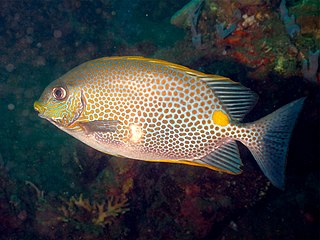
The orange-spotted spinefoot, also known as the deepbody spinefoot, gold-saddle rabbitfish, golden rabbitfish, golden-spotted spinefoot, goldlined spinefoot or yellowblotch spinefoot, is a species of marine ray-finned fish, a rabbitfish belonging to the family Siganidae. It is found in the eastern Indian Ocean and western Pacific Ocean. It occasionally makes its way into the aquarium trade.
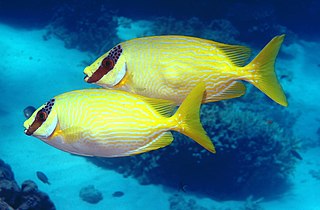
The masked spinefoot, also known as the masked rabbitfish, bluelined rabbitfish, blue-lined spinefoot, decorated rabbitfish or maiden spinefoot, is a species of marine ray-finned fish, a rabbitfish belonging to the family Siganidae. It occurs in shallow, coral-rich areas of clear lagoons and seaward reefs of the Indo-West Pacific region.
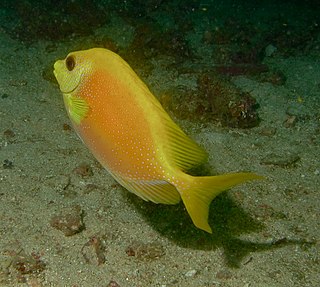
The blue-spotted spinefoot, the coral rabbitfish, coral spinefoot, ocellated spinefoot or orange spinefoot is a species of marine ray-finned fish, a rabbitfish belonging to the family Siganidae. It is found in the Indo-Pacific where it is often caught as a food fish and occasionally as an aquarium fish.

The streaked spinefoot, also known as the Java rabbitfish, blue-spotted spinefoot, blue-spotted trevally, Java spinefoot or white-spotted rabbit-fish, is a species of marine ray-finned fish, a rabbitfish belonging to the family Siganidae. It is found throughout most of the Indo-Pacific region.

Siganus doliatus, commonly known as the barred spinefoot, scribbled rabbitfish, pencil-streaked rabbitfish, barred Spanish mackerel, blue-lined rabbitfish or two-barred rabbitfish, is a species of marine ray-finned fish, a rabbitfish belonging to the family Siganidae. It is native to the western Pacific Ocean where it occurs on reefs and in lagoons.

Siganus insomnis, the bronze-lined spinefoot, is a species of marine ray-finned fish, a rabbitfish belonging to the family Siganidae. It is found in the northern central Indian Ocean. It had formerly been confused with S. lineatus, but was recognized as a separate species in 2014.

The golden-lined spinefoot, also known as the goldlined rabbitfish or lined rabbitfish, is a species of marine ray-finned fish, a rabbitfish belonging to the family Siganidae. It is found in the tropical Western Pacific and along the coasts of northern Australia.

The vermiculated spinefoot, also known as maze rabbitfish, scribbled spinefoot or vermiculate rabbitfish, is a species of marine ray-finned fish, a rabbitfish belonging to the family Siganidae. Like all rabbitfishes, it has venomous spines on the dorsal, anal, and pelvic fins. It is a reef associated fish species of the Indo-West Pacific region. It is a common commercially important fish in many tropical countries.

Siganus virgatus, the barhead spinefoot, doublebar rabbitfish or doublebar spinefoot is a species of marine ray-finned fish, a rabbitfish belonging to the family Siganidae. It is found in the Indo-Pacific region.
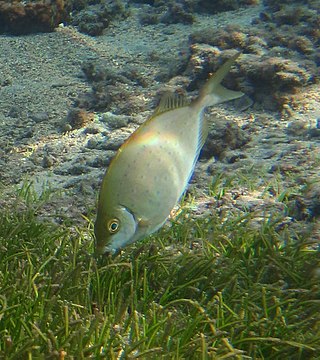
Siganus sutor, the shoemaker spinefoot rabbitfish ,whitespotted rabbitfish or African whitespotted rabbitfish, is a species of marine ray-finned fish, a rabbitfish belonging to the family Siganidae. It lives in Indo-Pacific coral reefs. It is endemic to the Indian Ocean, from Indonesia to Comoros. S. sutor is one of the commercial marine fishes, which is ubiquitously caught, in Tanzania and the entire East African coast of the Indian Ocean. S. sutor is among the most common fish species in the marine fisheries of Kenya, and accounts for around 40% of the artisanal fishery landings. Various fishing gears are used to target the siganids, but basket traps are the preferred ones. It is one of the mangrove/seagrass-associated coral reef fishes. This species inhabits littoral areas and its fin spines are venomous to humans.

Siganus canaliculatus, the white-spotted spinefoot, white-spotted rabbitfish, pearly spinefoot, seagrass rabbitfish, slimy spinefoot or smudgespot spinefoot is a species of marine ray-finned fish, a rabbitfish belonging to the family Siganidae. It is native to the western Pacific Ocean and Indian Ocean where it occurs on reefs and in lagoons.

Siganus fuscescens, the mottled spinefoot, black rabbitfish, black spinefoot, dusky rabbitfish, fuscous rabbitfish, happy moments, mi mi, pearl-spotted spinefoot, pin-spotted spinefoot, stinging bream or West Australian rabbitfish, is a species of marine ray-finned fish, a rabbitfish belonging to the family Siganidae. It is found in the Western Pacific Ocean.
The blackeye rabbitfish is a species of marine ray-finned fish, a rabbitfish belonging to the family Siganidae. It is found in the Indian Ocean.
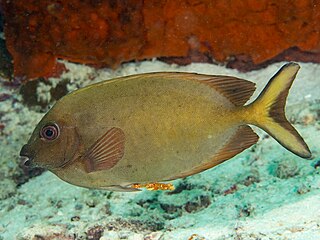
The peppered spinefoot, also known as the finespotted rabbitfish, is a species of marine ray-finned fish, a rabbitfish belonging to the family Siganidae. It occurs in the Indo-West Pacific region.

Siganus punctatus the goldspotted spinefoot, goldspotted rabbitfish, punctuated spinefoot, spotted rabbitfish, spotted spinefoot or yellow-spotted spinefoot, is a species of marine ray-finned fish, a rabbitfish belonging to the family Siganidae. It occurs in the Indo-West Pacific region.

Siganus randalli, the variegated spinefoot or Randall's rabbitfish, is a species of marine ray-finned fish, a rabbitfish belonging to the family Siganidae. It is found in the Western Pacific Ocean.

Siganus spinus, the little spinefoot, scribbled rabbitfish, blunt-nosed spinefoot, spiny rabbitfish, or spiny spinefoot, is a species of marine ray-finned fish, a rabbitfish belonging to the family Siganidae. It is found in the Indo-Pacific region.

Siganus stellatus, the brown-spotted spinefoot, brown-spotted rabbitfish, honeycomb rabbitfish, starspotted spinefoot, starspotted rabbitfish or stellate rabbitfish is a species of marine ray-finned fish, a rabbitfish belonging to the family Siganidae. It is found in the Indo-Pacific region.
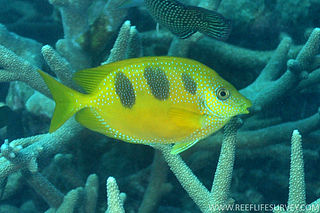
Siganus trispilos, the threeblotched rabbitfish, threespot rabbitfish, threeblotch spinefoot or threespot spinefoot is a species of marine ray-finned fish, a rabbitfish belonging to the family Siganidae. It is endemic to the eastern Indian Ocean off northwestern Western Australia.





















